Lallart M. Ferroelectrics: Characterization and Modeling
Подождите немного. Документ загружается.


Nonlinearity and Scaling Behavior in a Ferroelectric Materials
499
Introducing Eq. (19) in the previous calculations leads to:
00
0
(, ) ( ,)
2. . ( , ).
dP E dP E
PE p
dE d
θθ
αβ θ
θ
+==
(20)
00
0
(, ) ( ,)
(2..(,))
dP E dP E
p
dE P E d
θθ
αβ θθ
==
+
(21)
The function
0
2. . ( , )PE
α
β
θ
+ does not depend on temperature.
Thus, Eq. 21 can be written as
()
00
0
(, ) ( ,)
2. . ( , ).
dP E dP E
p
dE d P E
θθ
αβ θθ
==
+
(22)
According to Fig. 4, for a given value of polarization (P), we can write the following equality
00
(, ) ( ,)PdPE dPE
θθ
==
Thus,
0
2. . ( , )).EPE
α
β
θθ
Δ≡ + Δ and
0
2. . ( , ))
E
PE
θ
α
β
θ
Δ
Δ≡
+
(23)
With;
0
EEE EΔ≡ − =
and
0
θθθ
Δ=−
The term
0
2. . ( , )).PE
α
β
θθ
+Δ
can thereby be considered to play an equivalent role as that of
the electric field (ΔE). Such a statement is fraught with a consequence, since this equivalence
must be preserved for all cycles (P, Γ or coefficients). Moreover,
0
( 2. . ( , )).PE
α
β
θθ
+Δ is
equal to
.
C
αθ
Δ
(,0)
CC
EP
αθ
×Δ = =
when the temperature tends to Curie temperature (θ
C
).
The equivalence thus precisely implies that the couple
0
EEc
P
=
=
is equivalent to the
couple
0
C
P
θθ
=
=
. Hence;
0
lim ( 2. . ( , )). )
C
C
PE E
θθ
α
β
θθ
→
+Δ==>
0
lim ( 2. . ( , ))
C
C
C
E
PE
θθ
α
β
θα
θ
→
+==
Δ
(24)
As illustrated in Fig. 4, the scaling law can be used to derive the behavior of the polarization as
a function of the temperature P(θ) from P(E) cycle, or reciprocally to drive the polarization
behavior versus the electrical field, once the P(E) cycle is known.
3.2 Verification of the scaling law
The effects of various electric fields and temperatures on the polarization profile are
illustrated in Figure 5, where Figure 5(a) represents the polarization variation as a function
of the temperature for an electric field E=0 V/mm. It was shown by Hajjaji et al [15] that the
depolarization as a function of the temperature was mainly due to the decrease in the dipole
moment and the fact that the variation in this dipole moment was reversible. In the vicinity
of the ferroelectric to paraelectric transition, the temperature depolarization of the ceramics

Ferroelectrics - Characterization and Modeling
500
Fig. 4. Schematic illustration of the temperature/electric field scaling law
was the result of a 0–90° domain switching, whereas a 0–180° domain switching did not
occur with temperature. The effects were thus quite obvious. At a fixed
θ
(cf. Fig. 2(b)), the
polarization variation was minor for low applied electric fields. It then began to increase as
E increased gradually from 350 V/mm (a value close to Ec). For the electric field, the
depolarization of the ceramic was governed by the domain wall motion. As demonstrated
by Pruvost et al.[27], the depolarization process under an electric field was more
complicated than its counterpart under a compressed stress or temperature in the sense that
the electric field depolarization involved more than one mechanism. For electric tetragonal
ceramics; there existed three possibilities for domain switching: 0–90°, 90–180°, and 0–180°.
It should be pointed out that the focus of the present study was to investigate the
characteristics of the polarization variation when the sample was in a stable state. For this,
the employed fields (E) were below 450 V/mm (E<Ec) and the temperature dependence
took place below 373 K.
Despite the difference between the mechanisms of depolarization as a function of electric
field and temperature, we have try determining a law that links the two (electric field E and
temperature θ) and to identify one from another.
In order to obtain a suitable scaling relation for the ceramic, one can first follow the
suggested scaling law given in Eq. (23). This enables a direct determination of the
proportionality coefficients α and β from the experimental data. The coefficient α can be
determined from the following equation (24)
(4300)
C
C
E
α
θ
==
Δ
. According to Fig 5(a and b),
a plot of the eclectic field (ΔE) as a function of Δθ renders it possible to obtain the coefficient
β (β=3000). Based on the plot in Figure 3, it was revealed that the experimental data could be
fitted (with R
2
=0.99), within the measured uncertainty, by:
0
( 2. . ( , )).EPE
α
β
θθ
Δ= + Δ
.
In addition, the viability of the proposed scaling law was explored by way of two distinct
experiments on soft PZT. Starting from the experimental depoling under temperature P(
θ
),
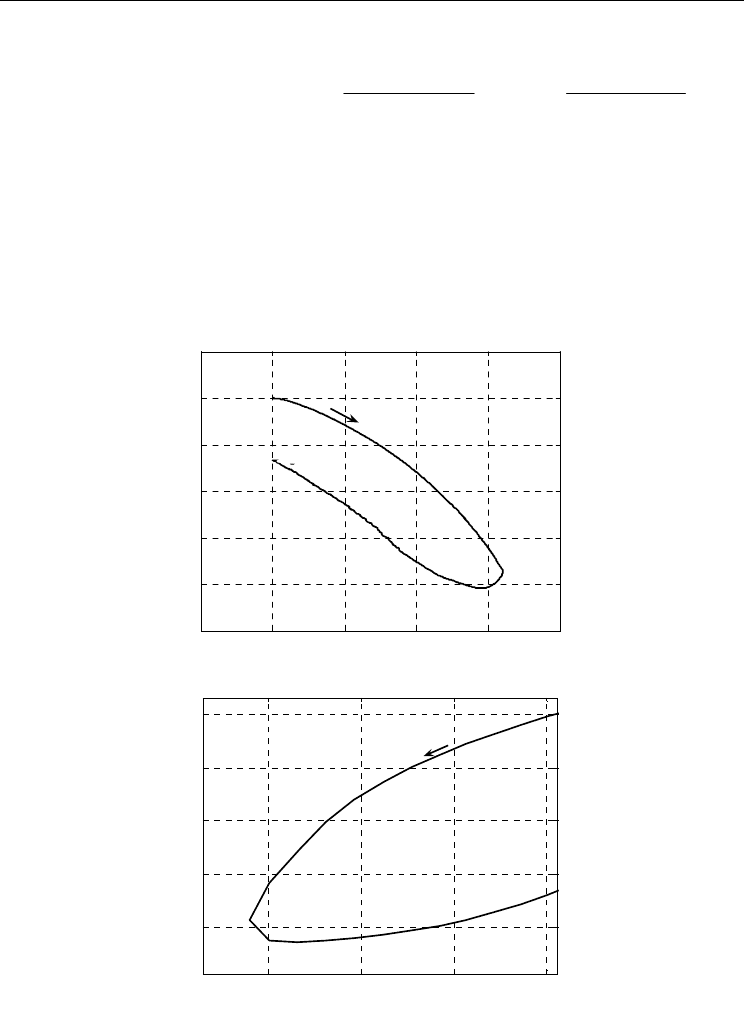
Nonlinearity and Scaling Behavior in a Ferroelectric Materials
501
the depoling was plotted as a function of (α+2.β.P(E
0
,θ)×Δθ) (giving P(α+2.βP(E
0
,θ)×Δθ) and
was compared to the direct measurement of P(E). The experimental result under an electric
field, P(E), was plotted as a function of
0
(2..(,))
E
PE
αβ θ
+
(giving
0
()
2. . ( , )
E
P
PE
α
β
θ
+
) and
was compared to the direct measurement of P(θ). This is depicted in Figure4.
The second comparison was helpful in determining the appropriateness of the scaling law
for fields close to the coercive field (E
c
). In this area, a small portion of the curve P(E)
produced a wide range of temperatures on the line P(
θ
), due to
θ→θ
C
when E
→
Ec (cf.
Figures 6 and 7). In a general manner, the experimental and reconstructed cycles were in
reasonably good agreement, with regard to both increasing and decreasing paths. This
decent correlation for both the P(E) and P(
θ
) cycles thus confirmed the viability of the
scaling law.
280 300 320 340 360 380
0.1
0.12
0.14
0.16
0.18
0.2
0.22
Temperature (°K)
Polarization (C/m²)
-3 -2 -1 0
x 10
5
0.12
0.14
0.16
0.18
0.2
Electric field (V/m)
Polarization (C/m²)
Fig. 5. (a) Polarization versus electric field on Pb(Mg
1/3
Nb
2/3
)
0.75
Ti
0.25
O
3
ceramic. (b)
Polarization versus temperature on Pb(Mg
1/3
Nb
2/3
)
0.75
Ti
0.25
O
3
ceramic
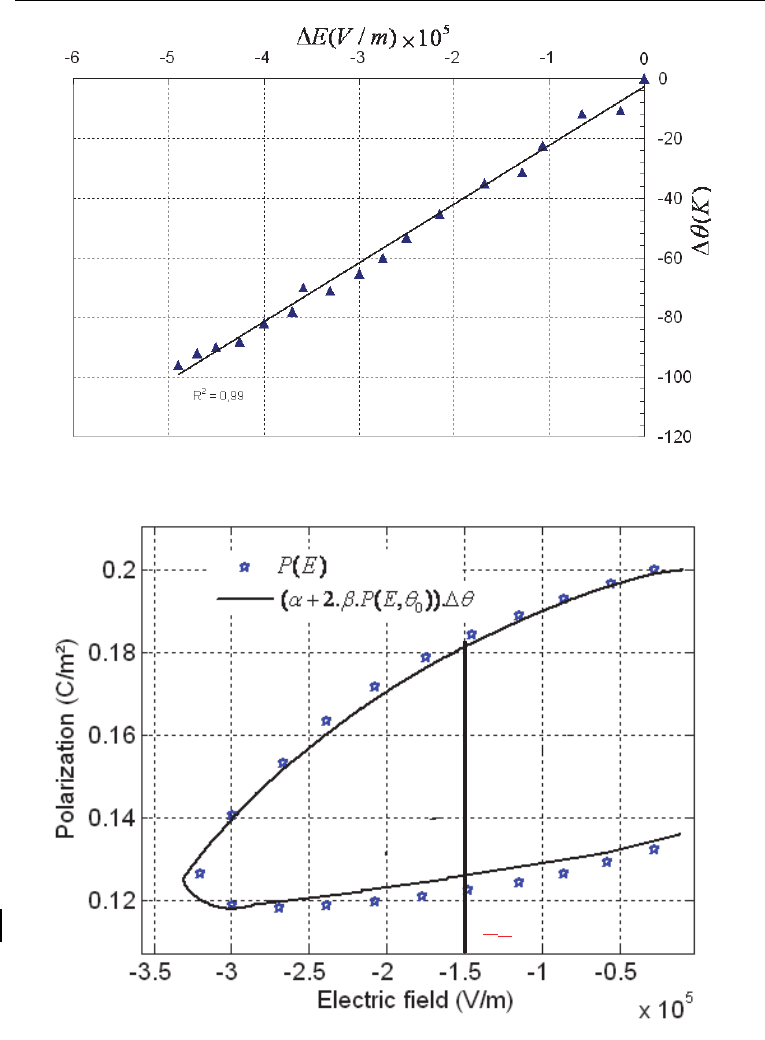
Ferroelectrics - Characterization and Modeling
502
Fig. 6. Scaling of electric field against (Δθ) for Pb(Mg
1/3
Nb
2/3
)
0.75
Ti
0.25
O
3
ceramic
Fig. 7. Experimental validation of the scaling law for PMN-25PT ceramic
E
M

Nonlinearity and Scaling Behavior in a Ferroelectric Materials
503
It is interesting to note that for purely electrical measurements, the presented law rendered
it possible to determine the maximum temperature for practical use (cf. Figure 7). Small
variations in polarization were observed for an applied electric field lower than E
M
(here,
150 V/mm), leading to the conclusion that the polarizations underwent a rapid change.
Based on the obtained E
M
value, one can determine the equivalent temperature (θ
M
)
corresponding to the maximum temperature used.
The relationship
0
2. . ( , )
E
PE
θ
α
β
θ
Δ=
+
leads to both a negative, i.e.,
min
min
min 0
2. . ( , )
E
PE
θ
α
β
θ
Δ=
+
, and a positive, i.e.,
max
max
max 0
2. . ( , )
E
PE
θ
α
β
θ
Δ=
+
, bound. The
absolute value of Δ
θ
min
can thus be considered to be much larger than Δ
θ
max
. Consequently, a
symmetric electrical field cycle would give rise to a dissymmetric cycle in terms of
temperature. Reciprocally, a symmetric temperature cycle would result in an asymmetric
cycle in terms of the electrical field.
4. Temperature/stress scaling in ferroelectrics
4.1 Presentation of the scaling law
In order to determine the general laws between the mechanical stress, electrical field, and
the temperature, we are based on previous studies of Guyomar et al [7]. These studies were
proposed a scaling effect between electric field and a term composed by the polarization
multiplied by the stress:
0
(, )ETPET
α
Δ≡Δ× (25)
Where α is the proportionality constant between ΔE and ΔT. Both ΔE and ΔT represent the
electric field and the mechanical stress variation. P(E,T
0
) is the polarization at zero
stress(T
0
=0MPa).
In the other study Hajjaji et al proposed a scaling law between the electrical field and the
temperature [16]. This law is expressed by the following expression.
0
(2 (,))EPE
χβ
θθ
Δ≡ + × ×Δ (26)
Here,
χ
and β are a two constant. P(E, θ
0
) is the polarization at room temperature (
θ
0
=298K) and Δθ is the temperature variation.
In most cases the coefficient
χ
is negligible compared to
0
2(,)PE
β
θ
× . Thus, the expression
(26) becomes:
0
(2 ( , ))EPE
β
θθ
Δ≡ × ×Δ
and
0
(2 . ( , ))
E
PE
θ
β
θ
Δ
Δ≡
×
(27)
With;
0
EEE EΔ≡ − = and
0
θθθ
Δ=−
According to equations (25) and (27) we find the following expression:
00
(, ) 2 (, )ETPET PE
αβθ
Δ≡Δ× ≡ ×
(28)
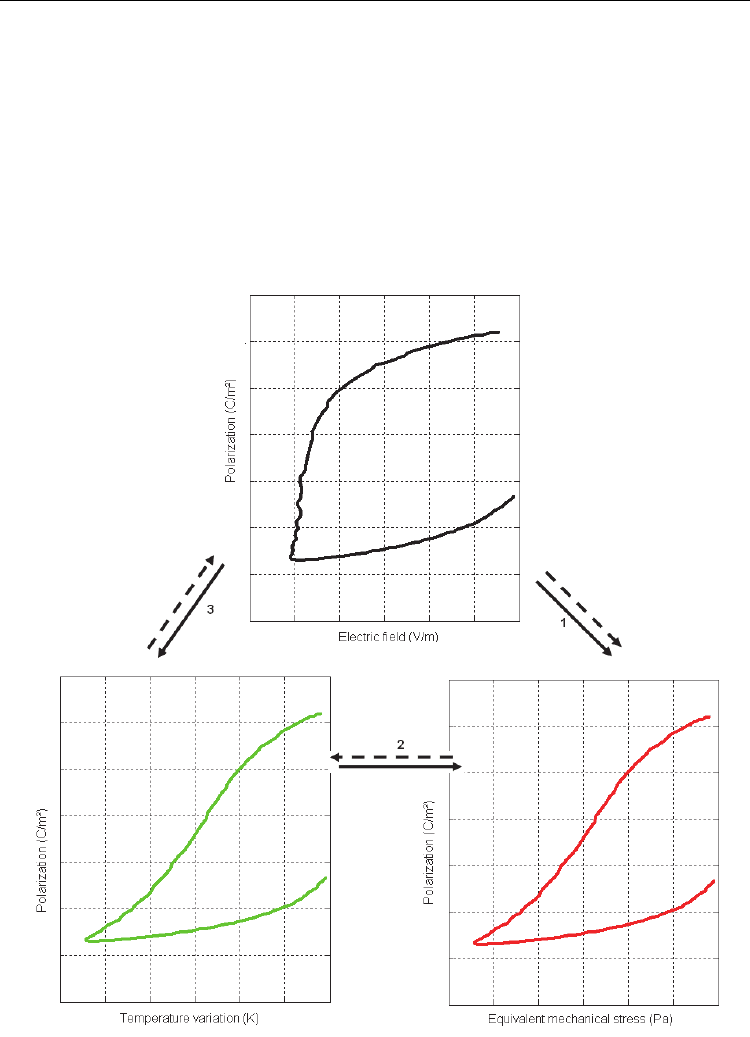
Ferroelectrics - Characterization and Modeling
504
00
(, ) (, )PET PE
θ
=
2T
α
β
θ
Δ≡ Δ (29)
With;
0
ETT TΔ≡ − = and
0
θθθ
Δ=−
0
( 298 )K
θ
=
Thus
T
δθ
≡×Δ (30)
As illustrated in figure 8, we determine P(T) and P(θ) from P(E) (steps 1 and 3), P(E) and
P(θ) from P(T) (steps 1 and 2), and at the end we can determine P(E) and P(T) from P(θ)
(steps 2 and 3),.
Fig. 8. Schematic illustration of the scaling laws
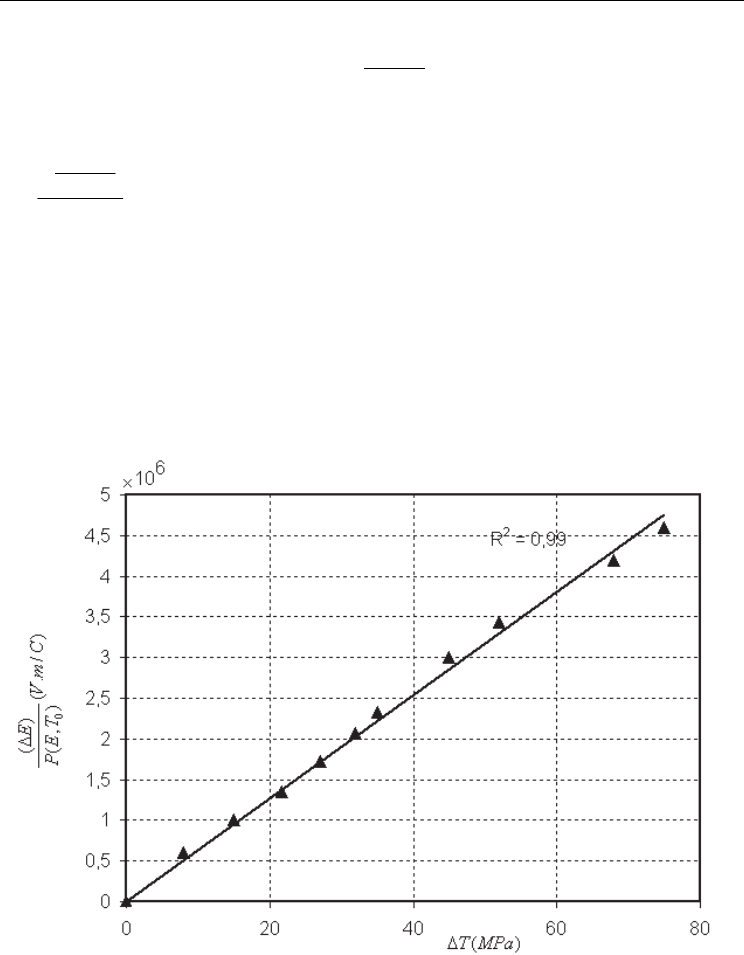
Nonlinearity and Scaling Behavior in a Ferroelectric Materials
505
4.2 Verification of the scaling law
Figure 9 shows the relation between ΔT and
0
(, )
E
PET
Δ
where good linear fits are apparent (R
close to 1). This implies a power-law relation between the mechanical stress and electric
field, i.e., (
0
(, )ETPET
α
Δ≡Δ× , the exponent α can be extracted from the slope, i.e.
0
()
()
(, )
()
E
d
PET
dT
α
Δ
=
Δ
.
The expression (25) allows expressing the mechanical stress as an equivalent electric field
and the electric field as an equivalent stress. Thus, a good agreement between electrical field
and mechanical stress proved that the proposed scaling law allows predicting the depoling
behavior under stress using only purely electrical measurements. Reciprocally, the
predictions of the depoling behaviour under an electrical field were permitted using only
purely mechanical measurements. It was found that such an approach permitted the
prediction of the maximal stress application from purely electrical measurements (i.e.,
measurements of S(E) and P(E)). The maximal stress for application is the stress that can be
applied to materials without they lose their piezoelectric properties.
Fig. 9. Experimental validation of the scaling law between electrical field and mechanical
stress for PZT ceramic
In the other study we proposed a scaling law between the electrical field and the
temperature [16]. This law is expressed by the expression (25) (
0
(2 ( , )).EPE
β
θθ
Δ≡ × Δ).
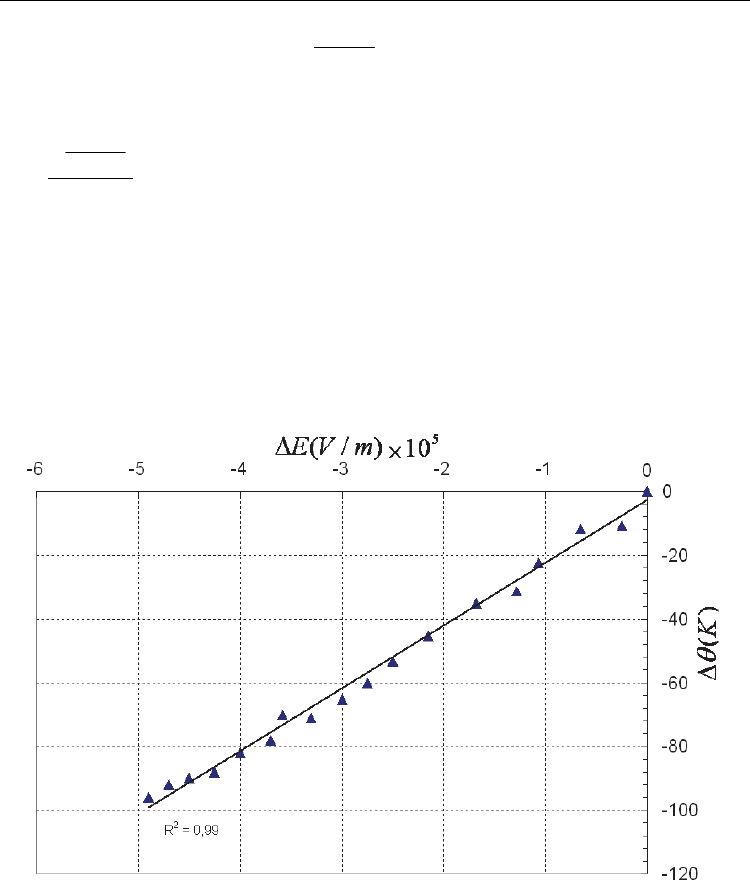
Ferroelectrics - Characterization and Modeling
506
Figure 10 shows the relation between
0
(, )
E
PE
θ
Δ
and
θ
Δ where good linear fits are apparent
(R close to 1). This implies a power-law relation between the temperature and electric field,
i.e., (
0
(2 ( , )).EPE
β
θθ
Δ≡ × Δ
), the exponent β can be extracted from the slope, i.e.
0
()
(, )
2
()
E
d
PE
d
θ
β
θ
Δ
=
Δ
.
According to this law, it is possible to determine the behavior of the polarization in function
of temperature from the electrical measurements. Reciprocally, it is possible to determine
the behavior of the polarization in function of the electric field from thermal measurements.
It is interesting to note that for purely electrical measurements, the presented law rendered
it possible to determine the maximum temperature for practical use. Small variations in
polarization were observed for an applied electric field lower than E
M
(here, 150 V/mm),
leading to the conclusion that the polarizations underwent a rapid change. Based on the
obtained E
M
value, one can determine the equivalent temperature (θ
M
) corresponding to the
maximum temperature used.
Fig. 10. Experimental validation of the scaling law between electrical temperature variations
for PZT ceramic
Considering physical symmetries, similar behaviors can be observed under stress or
temperature. Indeed both external disturbances may result in depling of the sample. We
consider here a scaling effect that is described with (equation 30): T
δθ
≡×Δ.
Where T is the mechanical stress,
θ
Δ the temperature variation, and
δ
the scaling
parameter. We therefore explore the viability of this assumption using two distinct
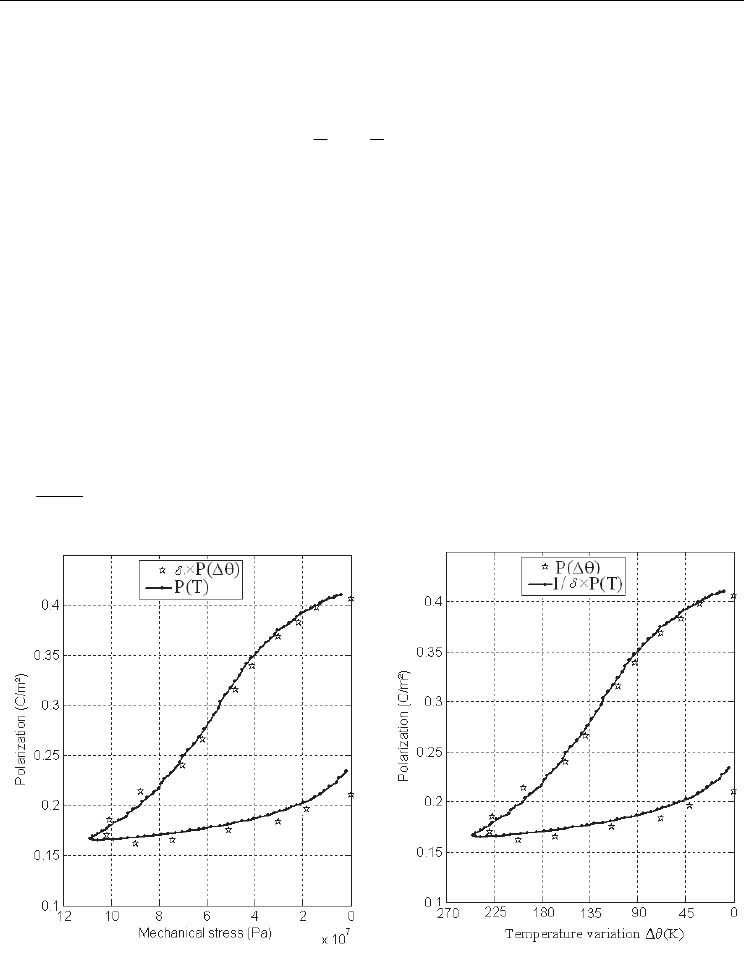
Nonlinearity and Scaling Behavior in a Ferroelectric Materials
507
experiments on the same PZT material. We record first the depoling under mechanical
stress. In a second time, we record the depoling under temperature. We try to obtain the
same depoling values under mechanical stress or temperature in order to compare therefore
the scaling effect. Starting from the experimental depoling under mechanical stress P(T), we
plot the depoling as a function of “
T
δ
” P(
T
δ
) and is compared to direct measurement
()P
θ
Δ . In the same manner the the experimental result under stress P(
θ
Δ ) is plotted as a
function of
δθ
×Δ (giving P(
δθ
×Δ )) and compared to the direct measurement P(T). In
figure 4 are shown these results. The agreement is outstanding considering the different
natures of mechanical stress and temperature. The two external disturbances acts very
differently on the domain configurations [8-11], but at the macroscopic scale, over an
important averaging, it is shown here that a very sharp scaling law can be considered. It is
important to note the consequences of such a scaling once it has been demonstrated
experimentally. It is possible to predict the poling behavior over the entire
stress/temperature plane as shown on figure 11.
In order to confirm these results, we plotted the mechanical stress as a function to the
temperature variation. Figure 12 shows the relation between Δθ and T, where good linear
fits are apparent (R2 close to 1). This implies a power-law relation between the stress and
temperature, i.e., (T
δθ
≡×Δ), the exponent
δ
can be extracted from the slope, i.e.
()
()
dT
d
δ
θ
=
Δ
. According to figure 12, the coefficient
δ
is equal to 0.35×10
6
.
Fig. 11. Experimental validation of the scaling law for soft PZT ceramic.
In the literature, a majority of these phenomenological models are purely electric, mechanic,
or thermal [19-22]. Consequently, it is difficult to interpret the results as a function of the
combined to two or three excitations (mechanical stress and temperature for example).
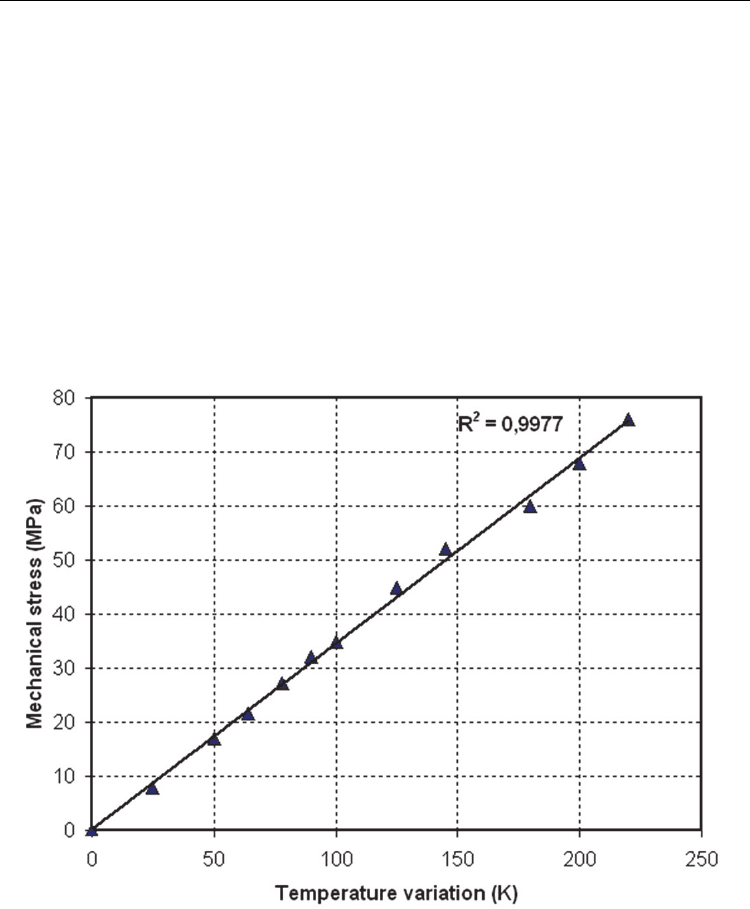
Ferroelectrics - Characterization and Modeling
508
The proposed scaling law can be used for several models have been proposed in the
literature for comprehending the hysteretic behavior of various materials, which renders it
interesting for introducing the temperature as an equivalent to the mechanical stress, or
reciprocally to introducing the mechanical stress as an equivalent to the temperature.
The behavior of ferroelectric materials under a combined mechanical stress (T) and
temperature (θ) can thus be determined, which will help in the identification and
understanding of the effect of the simultaneous action of temperature and mechanical stress
on ceramics.
According to this law, it is possible to determine the behavior of the polarization in function
of temperature from the mechanical measurements. Reciprocally, it is possible to determine
the behavior of the polarization in function of the mechanical stress from thermal
measurements. It is interesting to note that for purely mechanical measurements, the
presented law rendered it possible to determine the maximum temperature for practical use,
and reciprocally it is possible to determine the maximum stress for practical use from purely
thermal measurements.
Fig. 12. Experimental validation of the scaling law between mechanical stress and
temperature variation for PZT ceramic
5. Predictions of material behavior
Due to their electromechanical properties, piezoelectric materials are widely employed as
sensors and actuators [16-17]. Most of these piezoelectric materials are utilized under
